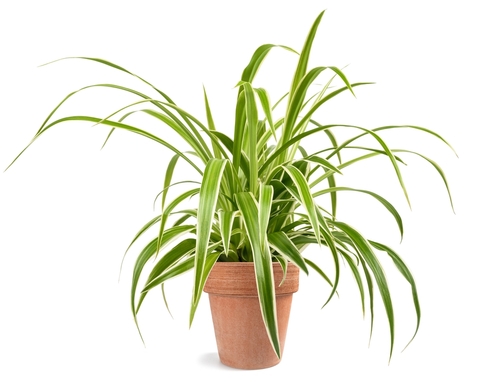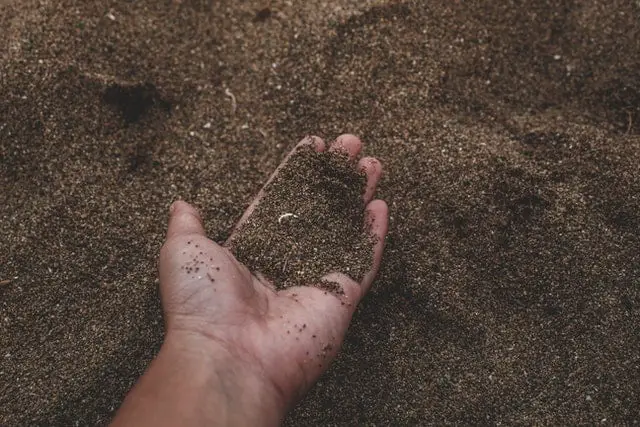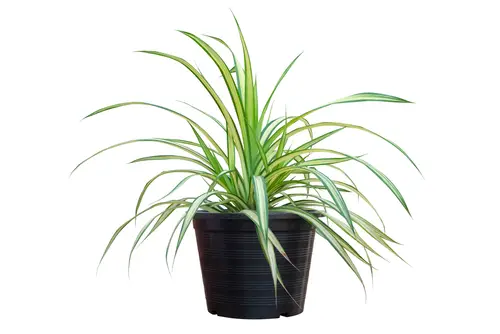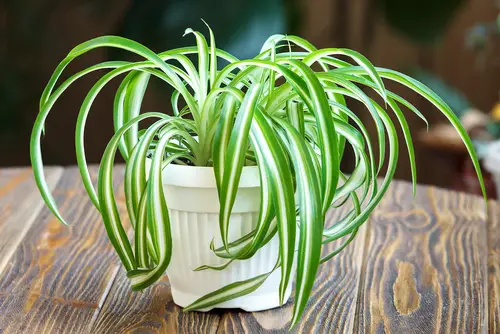Spider plants are a popular choice for houseplants due to their ease of care and attractive appearance. However, even the most well-cared-for spider plant can begin to show signs of distress and begin to die. When this happens, it’s important to identify the problem and take corrective action to revive the plant.
One of the most common reasons for a spider plant dying is related to watering and humidity issues. Overwatering can lead to root rot, while underwatering can cause the plant to wilt and dry out.
Additionally, spider plants prefer high humidity levels, so low humidity can cause the plant to suffer. Other factors, such as light and soil requirements, fertilizer and nutrient concerns, and pest and disease management, can also impact the health of a spider plant.
Key Takeaways on Spider Plant Dying
- Proper watering and humidity levels are crucial for a healthy spider plant.
- Light and soil requirements, fertilizer and nutrient concerns, and pest and disease management should also be considered when caring for a spider plant.
- Reviving a dying spider plant requires identifying the problem and taking corrective action.
See other reasons why your favorite houseplants might be dying & how to revive them:
Identifying the Problem
1. Recognizing Symptoms

Spider plants are known for their ability to thrive in various conditions, but sometimes they can start to show signs of distress. If you notice any of the following symptoms, your spider plant may be in trouble:
- Yellow or brown leaves
- Brown tips on the leaves
- Drooping or wilted foliage
- Discolored leaves
- Small holes in the leaves
- Decline in overall health
It’s important to identify the symptoms early on so you can take action to save your plant.
2. Common Causes
There are several common causes of spider plant decline that you should be aware of.
3. Overwatering
Overwatering is one of the most common causes of spider plant death. If the soil is constantly wet, the roots can begin to rot, which will cause the plant to wilt and decline. Make sure to let the soil dry out between waterings and avoid letting the plant sit in standing water.
4. Lack of Light
Spider plants require bright, indirect light to thrive. If they are not getting enough light, they may start to show signs of decline, such as yellowing leaves and stunted growth. Make sure to place your spider plant in a well-lit area, but avoid direct sunlight.
5. Low Humidity
Spider plants prefer a humid environment, so if the air in your home is dry, they may start to show signs of distress, such as brown tips on the leaves. You can increase humidity by misting the plant or placing a humidifier nearby.
6. Nutrient Deficiencies
Spider plants require certain nutrients, such as nitrogen and potassium, to grow and thrive. If they are not getting enough nutrients, they may start to show signs of decline, such as yellowing leaves. Fertilize your spider plant with a balanced fertilizer every few months to ensure it is getting the nutrients it needs.
7. Pests
Spider mites and mealybugs are common pests that can infest spider plants and cause them to decline. Check your plant regularly for signs of pests, such as webbing or small white bugs on the leaves. If you notice any pests, treat the plant with an insecticide.
Watering and Humidity Issues

Spider plants are relatively easy to care for, but they can still be susceptible to issues related to watering and humidity. Overwatering and underwatering are common problems that can lead to a dying spider plant. Additionally, spider plants require a certain level of humidity to thrive.
1. Overwatering
Overwatering is one of the most common problems that can lead to a dying spider plant. When the soil is constantly wet, the roots can become waterlogged, which can lead to root rot. Signs of overwatering include yellowing leaves, wilting, and a mushy stem.
To prevent overwatering, it is important to have a proper watering schedule. Spider plants prefer to dry out slightly between waterings, so it is important to allow the soil to dry out before watering again. Additionally, it is important to ensure proper drainage by using a well-draining potting mix and a pot with drainage holes.
2. Underwatering
Underwatering can also lead to a dying spider plant. When the soil is too dry, the leaves can become brown and crispy. Spider plants are drought-resistant, but they still require regular watering.
To prevent underwatering, it is important to ensure that the soil is consistently moist. However, it is important to avoid water stress by not letting the soil become too dry or too wet. It is also important to avoid using distilled water, which can be too pure and lack the necessary minerals that plants need.
3. Humidity Requirements
Spider plants are native to South Africa, where they thrive in warm tropical climates with relatively high humidity and moderate rainfall. Therefore, spider plants require a certain level of humidity to thrive.
To ensure proper humidity levels, it is important to mist the leaves regularly or place a saucer of water near the plant. Additionally, it is important to avoid placing spider plants near air conditioning or heating vents, which can dry out the air. Using a humidifier can also help maintain proper humidity levels.
Light and Soil Requirements
Lighting Needs
Spider plants require bright, indirect sunlight. Direct sunlight can scorch the leaves, while low light conditions can cause the plant to become leggy and weak. If the plant is not receiving enough light, it will not produce the vibrant green foliage that it is known for.
If the spider plant is receiving too much sunlight, the leaves will begin to turn yellow and brown. It is important to find a location that provides bright, indirect sunlight for the plant to thrive.
Soil Preferences

Spider plants prefer well-draining potting soil. The soil should be moist, but not waterlogged. Overwatering can lead to root rot, which can be fatal for the plant. It is important to allow the top layer of soil to dry out before watering again.
If the spider plant is in a pot that is too small, the soil may dry out too quickly. Transplanting the plant into a larger pot with fresh, new potting soil can help ensure that the plant has the proper soil conditions to thrive.
Fertilizer and Nutrient Concerns
Spider plants require a moderate amount of fertilizer to maintain their health and vitality. However, overfertilization can cause brown leaf tips, while nutrient deficiencies can lead to stunted growth and yellowing leaves.
Nutrient Deficiency
Spider plants require a balanced mix of nutrients, including nitrogen, phosphorus, and potassium, to thrive. A deficiency in any of these nutrients can cause the plant to suffer.
For example, a lack of nitrogen can cause the leaves to turn yellow and become stunted, while a lack of phosphorus can lead to poor root development and weak stems.
To prevent nutrient deficiencies, it is essential to use a high-quality fertilizer that contains all the necessary nutrients. Spider plants should be fertilized once a month during the growing season and once every two months during the winter.
Overfertilization
Overfertilization can be just as harmful to spider plants as nutrient deficiencies. Excess fertilizer can cause the tips of the leaves to turn brown and can even kill the plant.
To avoid overfertilizing, it is essential to follow the manufacturer’s instructions carefully. Spider plants should only be fertilized with a balanced, water-soluble fertilizer suitable for houseplants. It is also important to avoid fertilizing the plant during the winter months when it is not actively growing.
Pest and Disease Management
Spider plants are known for their hardiness, but they are not immune to pests and diseases. Proper care and management are necessary to keep them healthy and thriving. This section will cover some of the common pests, diseases, and conditions that affect spider plants, as well as how to manage them.
Common Pests

Spider mites, aphids, whiteflies, and mealybugs are some of the common pests that can infest spider plants. These pests can cause damage to the leaves, stunt growth, and even kill the plant if left untreated.
To manage these pests, it is recommended to use insecticidal soap or neem oil. These natural remedies are effective in controlling the pest population without harming the plant. Additionally, wiping the leaves with rubbing alcohol can help remove any sticky residue left by the pests.
Diseases and Conditions
Spider plants are susceptible to root rot and fluoride/chlorine toxicity. Root rot is caused by overwatering and poor drainage, which can lead to the roots becoming waterlogged and rotting. Fluoride/chlorine toxicity can occur when the plant is exposed to too much fluoride or chlorine in the water.
To prevent root rot, it is important to ensure that the plant has proper drainage and not to overwater it. If root rot has already set in, it may be necessary to repot the plant in fresh soil and cut away any affected roots. To prevent fluoride/chlorine toxicity, it is recommended to use distilled or filtered water when watering the plant.
Reviving Your Spider Plant
If you notice your spider plant is looking a little worse for wear, don’t worry. With a few simple steps, you can revive your plant and bring it back to its former glory. Here are some tips to help you revive your spider plant.
1. Repotting
One of the most common reasons for a dying spider plant is being root-bound. If you notice that the roots are starting to grow out of the drainage holes or the plant is struggling to absorb water, it’s time to repot.
Choose a new pot that is slightly larger than the current one and has drainage holes. Fill the pot with fresh potting soil and gently remove the plant from its old pot. Loosen the roots and place the plant in the new pot. Fill in any gaps with more potting soil and water thoroughly.
2. Pruning
If your spider plant is looking wilted or has yellow leaves, it may be time to prune. Use a pair of sharp scissors to trim away any dead or damaged leaves. This will help the plant focus its energy on new growth. You can also trim back any long, leggy stems to encourage new growth and a fuller plant.
3. Care

Spider plants are resilient and can bounce back quickly with the right care. Make sure your plant is getting enough indirect sunlight and water it when the top inch of soil feels dry to the touch.
Overwatering can lead to root rot, so be careful not to water too frequently. You can also fertilize your plant once a month during the growing season to give it an extra boost.
4. Propagating
If your spider plant is beyond saving, don’t worry. You can use the healthy parts of the plant to propagate new spider plants. Cut off a healthy stem with a few leaves and place it in a jar of water.
After a few weeks, roots will start to grow. Once the roots are a few inches long, you can plant the new spider plant in a pot filled with fresh potting soil.
Preventative Measures and Routine Care
Watering Routine
One of the most common reasons for spider plants to struggle is overwatering. Therefore, it is important to establish a consistent watering routine. Spider plants prefer to dry out slightly between watering, so it is recommended to water only when the top inch of soil is dry to the touch.
When watering, make sure to thoroughly saturate the soil and allow excess water to drain out of the pot. Avoid using tap water as it may contain chemicals that can harm the plant. Instead, use distilled or filtered water.
Lighting and Soil Routine
Spider plants prefer bright, indirect light. Direct sunlight can scorch the leaves, while low light can slow down growth. If the plant is not receiving enough light, it may go into dormancy. Therefore, it is important to place the plant in an area where it can receive bright, indirect light for several hours a day.
In terms of soil, spider plants prefer well-draining soil that is rich in organic matter. When repotting, use a pot that is only slightly larger than the current one. This will prevent the plant from becoming waterlogged and promote healthy root growth.
Fertilizing Routine
Spider plants do not require frequent fertilization. Over-fertilization can lead to yellowing of the leaves and ultimately, death of the plant. Therefore, it is recommended to fertilize only once a month during the growing season (spring and summer). Use a balanced, water-soluble fertilizer and dilute it to half strength before applying.
Pest and Disease Prevention
Spider plants are generally resistant to pests and disease. However, they can still fall victim to spider mites, mealybugs, and fungal infections. To prevent these issues, regularly inspect the plant for any signs of infestation or disease.
If an issue is detected, isolate the plant and treat it immediately with an appropriate solution. Additionally, maintaining a low humidity environment can prevent the growth of fungal spores and discourage pests from taking hold.
Frequently Asked Questions

How to save a spider plant from root rot?
If your spider plant is suffering from root rot, it is important to act fast to save it. Remove the plant from its pot and examine the roots. Cut away any soft, mushy, or discolored roots using a clean, sharp pair of scissors or pruning shears.
Repot the plant in fresh, well-draining soil and a pot with drainage holes. Water the plant sparingly until it recovers.
Why is my spider plant turning black?
If the leaves of your spider plant are turning black, it could be a sign of overwatering or root rot. Check the soil moisture level and make sure the plant is not sitting in water. If the soil is too wet, allow it to dry out before watering again. If the roots are rotted, follow the steps outlined above to save the plant.
What does spider plant root rot look like?
Spider plant root rot often appears as soft, mushy, or discolored roots. The leaves of the plant may also turn yellow or brown and fall off. If you suspect root rot, remove the plant from its pot and examine the roots.
How to revive a dying spider plant?
To revive a dying spider plant, first identify the cause of the problem. It could be due to overwatering, underwatering, poor soil quality, lack of light, or pests. Once you have identified the cause, take steps to correct it. Repot the plant in fresh soil, water it sparingly, and provide it with adequate light and nutrients.
Why is my spider plant drying up?
If your spider plant is drying up, it could be due to underwatering or lack of humidity. Make sure you are watering the plant regularly and providing it with enough moisture. You can also increase humidity levels by misting the plant or placing a tray of water nearby.
What to do if spider plant lost all leaves?
If your spider plant has lost all of its leaves, it may be too late to save it. However, you can try to revive it by following the steps outlined above. Repot the plant in fresh soil, water it sparingly, and provide it with adequate light and nutrients.
If the plant does not show any signs of recovery after a few weeks, it may be time to consider replacing it.

Hey, I’m Lisa and I’ve been an avid gardener for over 30 years. I love writing, talking and living in the garden! Feel free to connect with me on my socials below


